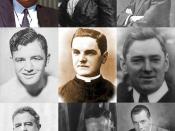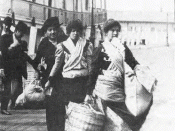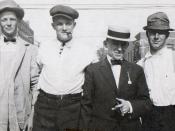The purpose of this essay is an analysis of the experience of early 20th century Irish immigrants to the United States.
My Irish ancestors came to the United States during the once called ÃÂEra of good feelingsÃÂ, which was led by James Monroe, but did not become popular until the 1830ÃÂs. Many Irish immigrants came to work leading the way to the Erie Canal which in turn led to other projects. Then led to working on the railroads. Many Irish migrated to England first, to gain experience and escape the famine before moving to the United States. Working on the railroads led to that experience and to process to migrate to England.
It was then in the mid- 1840ÃÂs the amount and nature of the Irish immigration drastically changed. The potato blight destroyed the crops and led to the famine of the Irish. The Irish were forced to leave there homes and forced to migrate to North America.
Before the famine the Irish had been poor and was the poorest in Europe during that time. They found themselves evicted from their already famished homes. The Irish fell victim to infectious diseases and cholera. One million people died more of cholera outbreak than of hunger. The other million and a half fled to North America to escape the hunger and mass evictions. The Irish came to North America out of desperation and the need to make a new start. With the Irish they brought with them diseases no sense of order and crime. The two main Newspapers at the time were The Boston Pilot and the New York Irish world. The newspaper gave a false hope to some of the Irish and spreading the word of the Irish migrating. The newspaper led to a scare which in return led to prejudice. The Pilot and the Irish world newspapers blamed England for the Struggling conditions the Irish endured in America.
Prior to 1870 the magazine that played a big part in the convicting the Irish, and the ÃÂinvasionÃÂ of the United States in the mid- 1800ÃÂs, ÃÂInsisted that the Irish to the exclusion of other subordinate groupsÃÂ were then entitled to a more honored position in the existing social hierarchy. In the early part of the immigrating process the Irish and the Negroes were compared to each other and shared the same degradation and were referred as to the ÃÂniggers that were turned inside out. While the Negroes were referred as the ÃÂsmoked IrishÃÂ, they both shared the same discrimination. The labors were often called the ÃÂIrish niggerÃÂ.
Jobs were scarce as employers were unwilling in hiring the ÃÂnewcomersÃÂ (Irish) in the working world. The women were stereotyped as ÃÂBiddiesÃÂ. The men became servants and took jobs that had no skills or opportunity to work and encountered the glass walls. Banks and other institutions refused to deal with the Irish. Avoiding to help the Irish help them to stay in a poor state for many years to come. Not only did the Irish deal with famine, discrimination, death, diseases and the struggle with Immigration in one country. They had to endure it all when they moved to the United States. This double jeopardy led to much of the Irish being in a mental state of defense and lashing out on the Americans. The Irish were poor, foreign and of Catholic religion and were labeled as ÃÂimpediment and a threat to society. Often competing with blacks while the blacks were free labor, they still had a hard time getting work.
The Irish is my Ethnic group and I have also seen only once the racism behind my group, I however can relate to the Irish being poor and having no resources to fall back on. I was once homeless and pregnant at the same time in 1989. I felt the need fit in and feel wanted and a part of society. My grandparents have endured the some of the pain of the Irish and even saw their parents struggle with the discrimination and religious ridiculing of the ÃÂAmerican peopleÃÂ in the late 1800ÃÂs. The Irish have come a long way in society. The group since then has planted their seed within our communities within the United States.
References(Mulcrone, 2003, pp. 49-72) http://swtuopproxy.museglobal.com/MuseSessionID=f1dc923efa392c58e8fc838d42c59856/MuseHost=web.ebscohost.com/MusePath/ehost/pdf?vid=4&hid=105&sid=49ff22b8-f909-4c74-b487-77692f41b686%40sessionmgr104(Unknown, unknown) http://www1.assumption.edu/ahc/Irish/overview.html





